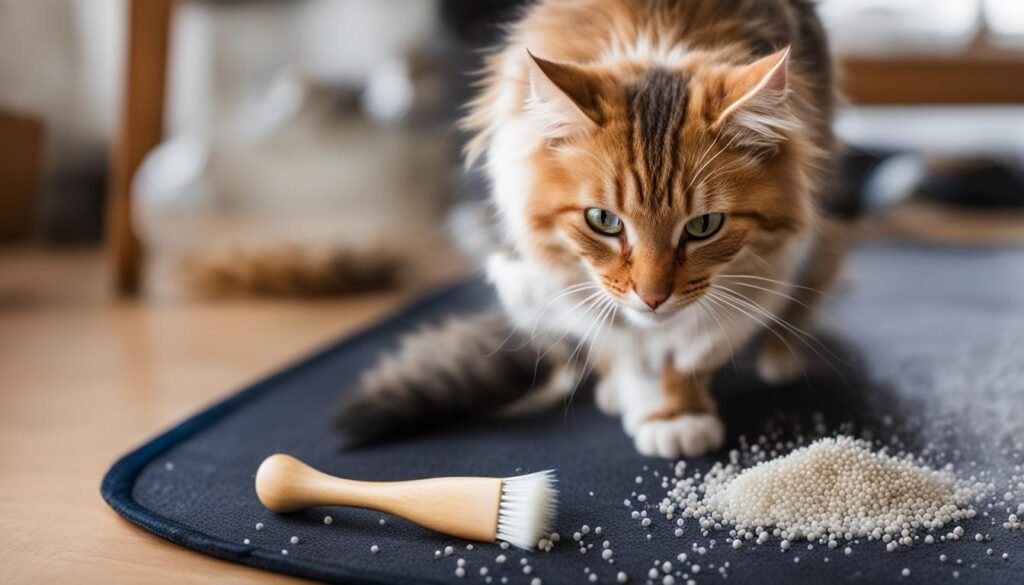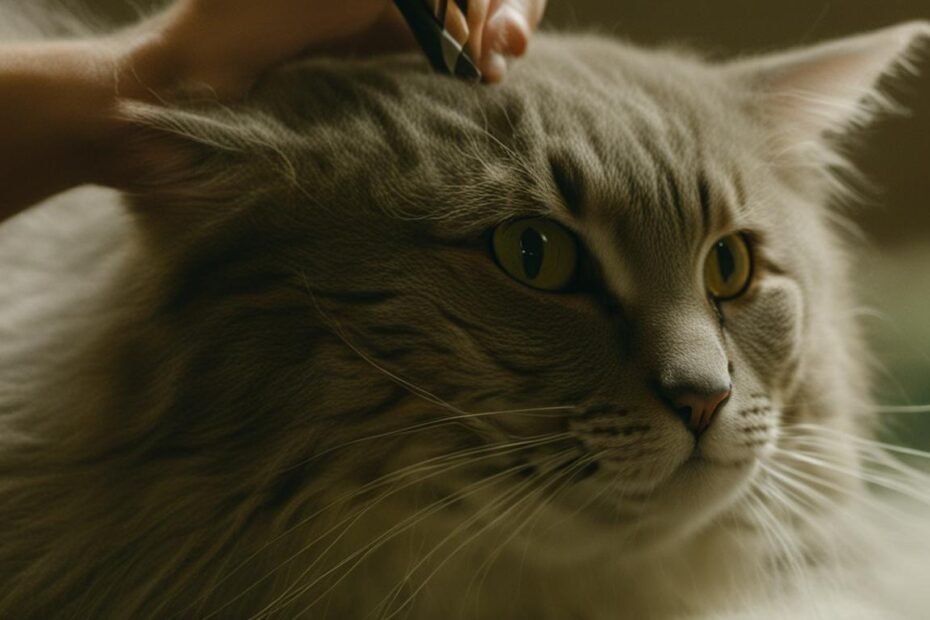Welcome to our comprehensive guide on cat hairball causes. If you’re a cat owner, you’re probably familiar with those pesky hairballs that your feline friend occasionally coughs up. But do you know what causes them and how to manage them effectively? In this guide, we’ll dive deep into the reasons behind cat hairballs and provide you with essential tips to prevent and address them. Let’s unravel the mysteries of cat hairball formation together!
Before we explore the prevention and management strategies, it’s important to understand the underlying causes of hairball formation. By gaining this knowledge, you’ll be better equipped to keep your cat happy and hairball-free. So, let’s get started!
Key Takeaways:
- Cats groom themselves and ingest loose hair, leading to the formation of hairballs.
- Long-haired breeds and cats that groom excessively are more prone to hairballs.
- Frequent or large hairballs can cause digestive issues in cats.
- Watch out for symptoms like vomiting, lack of appetite, weight loss, and lethargy.
- Regular grooming and dietary changes can help manage hairball issues at home.
Grooming Habits and Hairball Formation
Understanding how cats develop hairballs is essential in effectively managing their grooming habits. Cats groom themselves by licking their fur, which helps to clean and maintain their coats. However, during this process, loose hair is ingested and can accumulate in their stomach, leading to the formation of hairballs. This is more common in long-haired breeds such as Maine Coons and Persians, as their fur tends to shed more frequently.
Cats with excessive grooming habits are also at a higher risk of developing hairballs. These cats may groom other cats in the household or groom themselves excessively due to stress or anxiety. The ingested hair usually passes through the digestive tract, but in some cases, it can form a hairball in the stomach. Hairballs can potentially cause digestive problems, including obstructions and constipation.
It’s important for cat owners to be aware of the symptoms of a problematic hairball. These include frequent vomiting, lack of appetite, weight loss, and lethargy. If your cat exhibits any of these symptoms, it’s advisable to seek veterinary assistance to prevent any complications and ensure your cat’s well-being.

| Factors Contributing to Hairball Formation | Prevention Tips |
|---|---|
| Long-Haired Breeds | Regular Grooming |
| Excessive Grooming Habits | Dietary Changes |
| Fiber Intake |
Prevention and Management of Hairballs
Preventing and managing hairballs in cats requires regular grooming and dietary changes. By implementing these preventive measures, you can help reduce the formation of hairballs and promote healthy digestion in your feline friend.
Grooming Tips
Regular grooming is essential in minimizing the amount of loose hair your cat ingests. Brushing your cat’s fur daily, especially if they have long hair, helps to remove loose hair from their coat before they can swallow it. Use a brush or comb specifically designed for cats, and make sure to be gentle and patient during the grooming process.
Dietary Changes
Introducing fiber into your cat’s diet can help promote better digestion and prevent hairballs. Look for cat food brands that offer specialized formulas designed to control hairballs. These formulas often contain ingredients that improve skin health and digestion. Additionally, you can consider adding fiber supplements to your cat’s diet, as recommended by your veterinarian.
| Prevention Tips | Benefits |
|---|---|
| Regular grooming | Reduces loose hair ingestion |
| Dietary changes | Promotes better digestion |
| Specialized cat food formulas | Improves skin health and digestion |
| Fiber supplements | Aids in hairball passage |
Factors Contributing to Hairball Formation
Several factors can contribute to the formation of hairballs in cats. Understanding these factors can help cat owners take appropriate preventive measures to minimize hairball-related issues.
Obesity
Obesity is a significant contributing factor to hairball formation in cats. Excess weight can lead to decreased mobility, making it difficult for cats to groom themselves effectively. As a result, they may ingest more hair during grooming, increasing the chances of hairball formation. Maintaining a healthy weight through portion control and regular exercise can help reduce the risk of hairballs.
Dental Issues
Dental problems such as gum disease and tooth decay can also contribute to hairball formation. Cats with oral health issues may drool excessively, leading to increased grooming to clean their fur. This excessive grooming can result in more hair ingestion and hairball formation. Regular dental care, including professional cleanings and at-home oral hygiene practices, can help prevent dental issues and reduce the risk of hairballs.
Hair Length
Hair length plays a role in the frequency of hairball formation. Long-haired breeds, such as Maine Coons and Persians, are more prone to hairballs due to the higher amount of loose hair they have. The longer and thicker the hair, the more likely it is to accumulate in the digestive system and form hairballs. Regular grooming and periodic trimming of long hair can help minimize hairball formation in long-haired cats.
Dry Environment
A dry environment can contribute to hairball formation in cats. Dry air can lead to dry skin and increased shedding, resulting in more loose hair for cats to ingest. Maintaining a humid environment can help reduce shedding and hair ingestion. Using a humidifier in the home or providing a water fountain for your cat to increase moisture in the air can be beneficial in preventing hairballs.
| Contributing Factors | Potential Solutions |
|---|---|
| Obesity | Portion control, regular exercise |
| Dental Issues | Regular dental care, professional cleanings, oral hygiene practices |
| Hair Length | Regular grooming, periodic trimming of long hair |
| Dry Environment | Using a humidifier, providing a water fountain |
By addressing these contributing factors and implementing preventive measures, cat owners can reduce the occurrence of hairballs and promote better overall feline health and well-being.
Recognizing and Addressing Hairball-Related Issues
When it comes to hairball-related issues in cats, it’s important to be able to recognize the symptoms and take appropriate action. Hairballs are a common occurrence in feline companions, but sometimes they can cause digestive problems and discomfort. By understanding the symptoms and knowing when to seek veterinary assistance, you can ensure the well-being of your furry friend.
Symptoms of Hairball-Related Issues
There are several symptoms that may indicate a problematic hairball. Frequent vomiting, especially with traces of hair, can be a clear sign that your cat is experiencing difficulty with hairball expulsion. Additionally, a lack of appetite, weight loss, and lethargy may indicate that a hairball is causing digestive issues. If you notice any of these symptoms in your cat, it’s important to take action.
“Frequent vomiting, lack of appetite, weight loss, and lethargy may indicate that a hairball is causing digestive issues.”
When to Seek Veterinary Assistance
If your cat shows signs of distress when coughing up a hairball or exhibits symptoms of a blockage, it’s crucial to seek veterinary assistance immediately. These could be signs of a serious hairball-related issue that requires professional intervention. Your veterinarian can provide guidance and recommend appropriate treatment options to ensure your cat’s health and comfort.
Routine Check-ups for Hairball Prevention
Regular check-ups with your veterinarian are not only important for overall wellness but can also help prevent severe complications related to hairballs. During these visits, your vet can assess your cat’s health, including addressing any potential issues related to hairballs. By detecting and addressing these issues early on, you can effectively manage and prevent hairball-related problems.
Understanding the symptoms and knowing when to seek veterinary assistance are essential steps in addressing hairball-related issues in cats. By staying proactive and attentive to your cat’s well-being, you can ensure that they lead a happy and healthy life, free from the discomfort of hairballs.
Tips for Preventing Hairballs
Preventing hairballs in your cat is key to ensuring their overall health and well-being. By implementing effective preventive strategies and consistently providing the necessary care, you can minimize the occurrence of hairballs and keep your furry friend comfortable. Here are some tips to help you prevent hairballs:
Grooming:
Daily grooming is essential in reducing loose hair and preventing it from being ingested by your cat. Regular brushing, especially for long-haired breeds, can significantly decrease the amount of hair they swallow during grooming. Consider using a specialized cat brush or grooming glove to capture loose hair more effectively.
Dietary Changes:
Introducing fiber into your cat’s diet can promote better digestion and facilitate the passage of hairballs. Look for cat food formulas that are specifically designed to control hairballs. These formulas usually contain higher amounts of fiber and help improve skin health and digestion. Consult with your veterinarian for recommendations on the best diet for your cat’s needs.
Regular Vet Visits:
Scheduling regular check-ups with your veterinarian is crucial for detecting and addressing potential hairball-related complications early on. Your vet can provide personalized advice and guidance based on your cat’s specific needs. Routine check-ups also allow for preventive measures to be taken to ensure your cat’s optimal health.
By following these preventive strategies and maintaining regular vet visits, you can significantly reduce the occurrence of hairballs in your cat, keeping them happy and healthy.

Table: Dietary Recommendations for Hairball Prevention
| Food Name | Key Benefits |
|---|---|
| Brand A Hairball Control Formula | High fiber content for improved digestion |
| Brand B Digestive Health Formula | Added probiotics for digestive support |
| Brand C Skin and Coat Formula | Contains omega-3 fatty acids for healthy skin and reduced shedding |
Table: This table provides some dietary recommendations for hairball prevention in cats. These specialized formulas offer various benefits, such as high fiber content, added probiotics, and omega-3 fatty acids, to promote better digestion, reduce hairball formation, and support overall skin and coat health. Consult with your veterinarian to determine the most suitable option for your cat.
Conclusion
Understanding the causes of cat hairballs is essential in ensuring the well-being of your feline friend. By taking proactive measures, such as regular grooming and dietary changes, you can effectively manage and prevent hairball-related issues.
Regular grooming, particularly for long-haired breeds, can significantly reduce the amount of loose hair ingested by your cat. Introducing fiber into their diet helps improve digestion and facilitates the passage of hairballs.
Remember to prioritize routine veterinary visits to monitor your cat’s health and address any potential complications. If you notice symptoms of problematic hairballs, such as frequent vomiting or lack of appetite, don’t hesitate to seek professional assistance.
By implementing these preventive strategies and maintaining a close relationship with your veterinarian, you can ensure that your beloved cat enjoys a happy, healthy, and hairball-free life.
FAQ
What causes hairballs in cats?
Cats develop hairballs when they groom themselves and inadvertently swallow loose hair. Certain factors, such as long hair, excessive grooming, or being a long-haired breed, can increase the risk of hairball formation.
Are hairballs a cause for concern?
Hairballs are usually not a cause for concern. However, frequent or large hairballs can lead to digestive issues and discomfort for your cat.
What are the symptoms of a problematic hairball?
Symptoms of a problematic hairball include vomiting, lack of appetite, weight loss, and lethargy.
How can I manage hairballs at home?
Regular grooming, including daily brushing, can reduce the amount of loose hair your cat ingests. Introducing fiber into their diet and seeking veterinary advice when needed can also help manage hairball issues.
What factors contribute to hairball formation?
Factors such as obesity, dental issues, hair length, and a dry environment can contribute to the formation of hairballs in cats.
When should I seek veterinary assistance for hairballs?
If your cat shows signs of distress when coughing up a hairball or exhibits symptoms of a blockage, it’s crucial to seek veterinary assistance immediately.
How can I prevent hairballs in my cat?
Preventive strategies for hairballs include regular grooming, introducing fiber into your cat’s diet, and scheduling routine vet visits for early detection and treatment.
